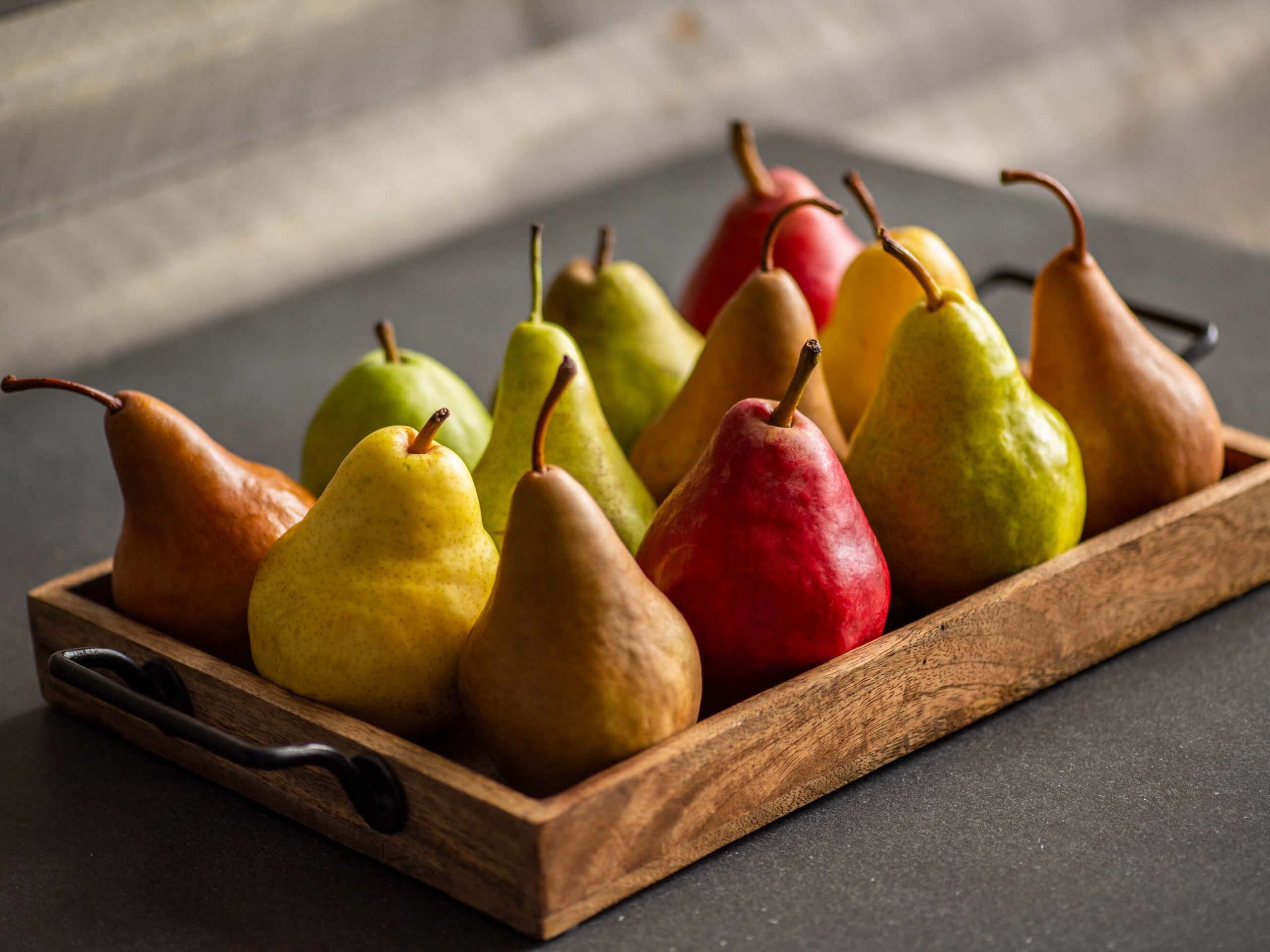Pear Nutrition Facts
Pears are among the most cultivated and most popular fruits in the world,1 and not just because they’re delicious. This humble little fruit supports a healthy heart and an active lifestyle, read on to learn why.

No-nonsense Nutrition: Heart-healthy and deliciously nutrient-dense
Nutrient-dense pears offer more nutrients for fewer calories, plus no sodium, fat, or cholesterol. For only 100 calories in a medium sized pear (about 166 grams), each pear packs in 21% daily value for fiber, 8% Vitamin C, 4% potassium, and a whole host of health benefits.
Fiber Powerhouse!
Pears rank higher than almost any fruit when it comes to dietary fiber, with 6 grams or 21% daily value in just one pear. For the value of fiber, look no further than your gastrointestinal tract and the helpful bacteria that live there! Fiber helps maintain balance, regularity, and reduces the risk of colorectal cancer. Dietary fiber also slows digestion in the upper gastrointestinal tract, so you feel fuller longer, and slows absorption of sugars, reducing sugar spikes and cravings.
Heart-healthy Potassium
Potassium is necessary for muscle contractions, including a regular heartbeat. Each medium pear is sodium-free but contains about 190 mg of potassium (4% daily value), a combination that supports a healthy heart!
Bring on the Vitamin C
Vitamin C is an important nutrient and strong antioxidant, and a little goes a long way! This powerful vitamin strengthens the immune system, heals wounds and bruises, builds strong bones and teeth, and even aids iron absorption. One medium pear provides 8% of your daily need for vitamin C!
Free of saturated fat, cholesterol, added sugars, and sodium
Eating less saturated fat, added sugar, and sodium may reduce risk for chronic illnesses, such as heart disease, high blood pressure, and weight gain. But, average intakes are higher in all age groups for US men and women than 2015-2020 Dietary Guidelines recommend. Simply swapping out one processed food for one pear each day can increase nutrient intake while decreasing saturated fat, cholesterol, added sugars, and sodium!
Polyphenol Phenom
Pears contain a network of phytonutrients – antioxidants concentrated in the peel. The humble pear packs a punch with polyphenols (especially flavonoids, like anthocyanins), anti-inflammatory terpenoids, and vitamin C that fend off damaging free radicals that can cause cancer, heart disease, and brain dysfunction!
Simple, Wholesome
Americans don’t eat enough fruit; only 12% of adults2 and 9% of teens3 meet fruit recommendations. The 2015-2020 Dietary Guidelines recommend all Americans consume 1.5 to 2 cups of fruit each day for better health and longevity. Pears are available year-round! Simply eating one medium-sized pear each day meets half this requirement!
Widespread Availability
Pears are among the most cultivated and most popular fruits in the world, and not just because they’re delicious! Pears from Oregon and Washington make up 88% of the pears you see in the grocery store year-round.
But don’t pears contain sugar?
Pears are a nutrient-dense, complex carbohydrate that contain sugars necessary for energy and tissue function – particularly the brain. In fact, according to the National Academy of Science, the brain alone needs at least 130 grams of carbohydrates each day, preferably from fruit, vegetables, and grains. And the fiber in pears helps limit sugar spikes for a steady supply of energy!
Don’t Weight
These plump little beauties won’t plump your waistline. In a nationally representative sample, people who consumed pears (approximately one per day) had higher diet quality, lower body weight, and were 35% less likely to be obese.4
1. Reiland H, Slavin J. Systematic Review of Pears and Health. Nutr Today. 2015; 50, 301-305.
2. Lee-Kwan SHP, Moore LVP, Blanck HMP, Harris DMP, Galuska DP. Disparities in State-Specific Adult Fruit and Vegetable Consumption – United States, 2015. Atlanta: U.S. Center for Disease Control; 2017 Nov 17 2017.
3. Moore LV, Thompson FE, Demissie Z. Percentage of Youth Meeting Federal Fruit and Vegetable Intake Recommendations, Youth Risk Behavior Surveillance System, United States and 33 States, 2013. Journal of the Academy of Nutrition and Dietetics. 2017; 117, 545-553.e543.
4. O’Neil C, Nicklas T, Fulgoni V. Fresh pear consumption is associated with a better nutrient intake profile, better diet quality, and lower risk of obesity in adults (19+ y): NHANES (2001-2010) (810.16). The FASEB Journal. 2014; 28, 810.816.
Learn more about pear nutrition!
Plant Power Your Eating
5 Tips for Plant-Powering Your Eating Style
A plant-based diet doesn’t mean that you have to give up meat altogether if you don’t want to; it just means that your diet focuses mostly on plants. This flexitarian eating style is linked with a boatload of benefits, such as lower risks of heart disease, type 2 diabetes, certain types of cancer and obesity, as well as lowering your carbon footprint.
LEARN MOREPears are an excellent source of fiber!
Pears and Fiber
Pears are one of the leading fruit sources of fiber. A medium-sized pear packs 6 grams of fiber, which equals about 21% of the recommended daily value. The skin contains the majority of the fiber found in a pear, so enjoy the skin for added flavor, texture, and nutrients.
LEARN MORE